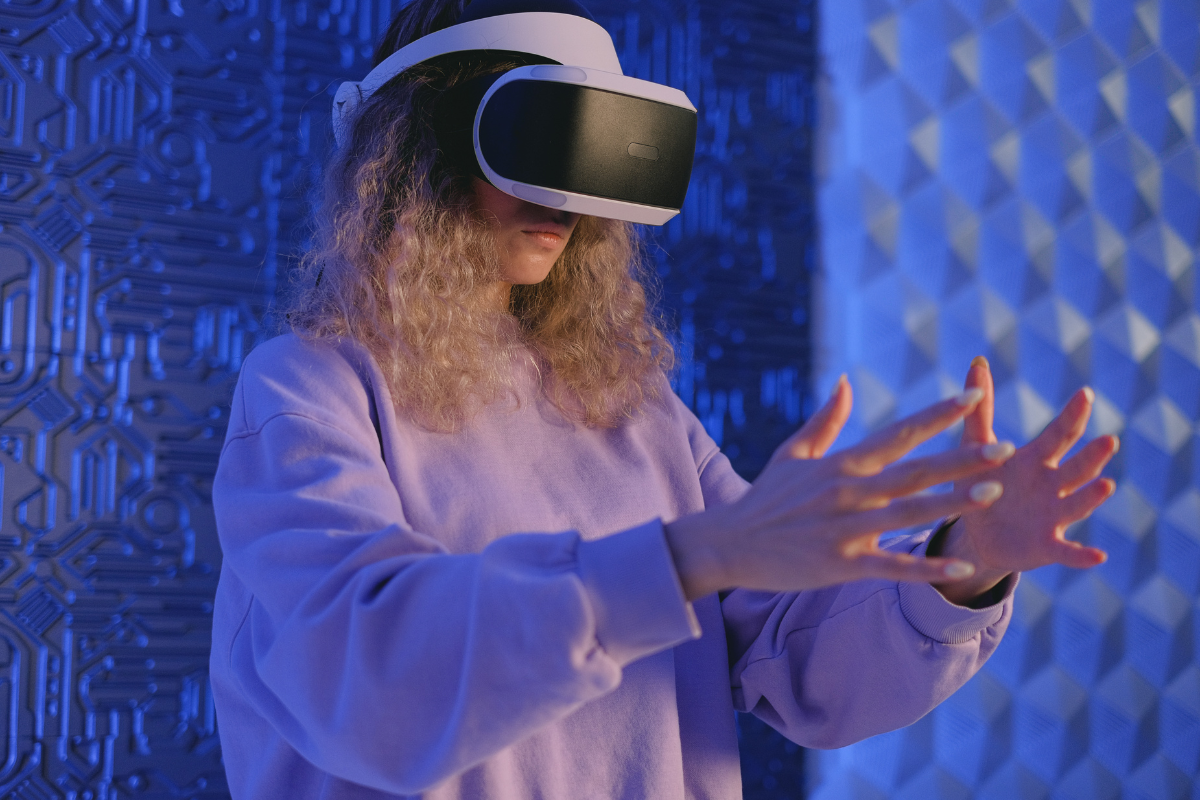Distinguishing Virtual Reality and Augmented Reality: A Comprehensive Exploration
In a world fueled by technological advancements, the realms of Virtual Reality (VR) and Augmented Reality (AR) have emerged as revolutionary forces, shaping how we perceive and interact with our environment. This article delves into the intricate nuances that set VR and AR apart, unraveling their unique attributes, applications, and potential impact on our lives.
- I. Introduction
- Definition of Virtual Reality (VR) and Augmented Reality (AR)
- The Rising Impact of Immersive Technologies
- II. Virtual Reality (VR) Unveiled
- Defining the Immersive World of VR
- Creating a Complete Digital Environment
- Immersion through Visuals and Audio
- Seamless Interaction in Virtual Realms
- III. Augmented Reality (AR) Demystified
- Enhancing the Real World with AR
- Overlaying Digital Elements onto Physical Environments
- The Integration of Digital Information and Reality
- The Significance of Real-time Interaction
- IV. Key Differences between VR and AR
- Fundamental Purpose and User Experience
- Level of Immersion and Detachment from Reality
- Interaction with the Physical Environment
- Applications and Industry Use Case
- V. The Intricacies of Virtual Reality (VR)
- VR's Profound Sense of Presence
- The Role of Headsets and Sensory Deprivation
- Achieving Suspension of Disbelief in Virtual Worlds
- Crafting Narratives That Resonate in Virtual Landscapes
- Empathy and Emotional Engagement through VR Narratives
- VI. Augmented Reality's (AR) Subtle Enchantment
- AR's Augmentation of Reality
- Overlaying Digital Information on Physical Spaces
- Enhancing Visual and Auditory Perceptions
- The Role of Smartphones, Smart Glasses, and Wearables
- Engaging with Augmented Content Seamlessly
- VII. Applications Across Industries
- AR's Integration into Everyday Experiences
- Augmented Reality in Retail and Shopping
- Navigation and Wayfinding with AR Technology
- VR's Computational Demands
- VIII. The Technological Backbone of VR and AR
- Graphics Rendering and Hardware Requirements
- Pushing the Boundaries of Processing Power
- AR's Real-time Data Processing
- Object Recognition and Spatial Mapping
- IX. Future Prospects and Evolving Landscape
- Reimagining the Workplace and Education through VR
- AR's Role in Enhancing Reality
- The Merging of Digital and Physical in Everyday Life
- X. Ethical Considerations and Societal Impact
- Navigating the Boundary Between Entertainment and Reality
- Privacy Concerns and Data Security in AR
- The Implications of Constant Data Collection in AR
- Summarizing the Differences Between VR and AR
- Anticipating the Continued Evolution of Immersive Technologies
I. Introduction
Definition of Virtual Reality (VR) and Augmented Reality (AR)
Virtual Reality (VR) and Augmented Reality (AR) represent two distinct but interconnected modes of immersive experience. VR transports users to entirely digital environments, whereas AR overlays digital information onto the physical world, enhancing our perception of reality.
The Rising Impact of Immersive Technologies
As technology continues to advance, the influence of VR and AR becomes more profound. From entertainment and education to industries like healthcare and architecture, these immersive technologies are reshaping how we interact with our surroundings and each other.
II. Virtual Reality (VR) Unveiled
Defining the Immersive World of VR
VR offers an all-encompassing digital experience that submerges users into computer-generated environments. Through the use of headsets and sensory inputs, VR engulfs our senses, blurring the lines between the real and virtual worlds.
Creating a Complete Digital Environment
The heart of VR lies in its ability to create entire realities from scratch. Visuals and audio work in tandem to transport users into these artificial landscapes, stimulating their senses and invoking a sense of presence.
Immersion through Visuals and Audio
In VR, captivating visuals and surround sound audio combine to create an immersive atmosphere. High-definition displays and realistic graphics ensure that every detail is meticulously rendered, enhancing the feeling of being physically present within the virtual space.
Seamless Interaction in Virtual Realms
VR’s success lies not just in its visuals, but in how users interact within these realms. Hand controllers and motion-tracking technology enable users to manipulate objects and navigate these synthetic worlds as if they were tangible.
III. Augmented Reality (AR) Demystified
Enhancing the Real World with AR
Unlike VR, which replaces the physical environment, AR enriches our surroundings with digital overlays. This augmentation occurs in real-time, providing users with supplementary information and experiences.
Overlaying Digital Elements onto Physical Environments
AR technology seamlessly merges digital and physical realities into a coherent experience. By capturing the real world through cameras and adding contextual information through software, AR blurs the line between what’s real and what’s digital.
The Integration of Digital Information and Reality
AR’s magic lies in its ability to seamlessly integrate digital data with real-world visuals. This integration allows for context-aware interactions, enhancing our understanding and engagement with the environment.
The Significance of Real-time Interaction
One of AR’s defining features is its real-time nature. As users move and interact within their physical surroundings, digital information adapts and responds accordingly. This dynamic interaction enhances the feeling of immersion and utility.
IV. Key Differences between VR and AR
Fundamental Purpose and User Experience
While both VR and AR are immersive technologies, they serve different fundamental purposes. VR aims for complete immersion, transporting users to new realities, whereas AR enhances the existing world by adding a layer of digital content.
Level of Immersion and Detachment from Reality
VR offers a heightened level of immersion, often disconnecting users from their physical surroundings entirely. AR, on the other hand, maintains a connection to the real world, allowing users to interact with both digital and physical elements.
Interaction with the Physical Environment
In VR, interactions are within the virtual environment, limited to digital objects and landscapes. AR, however, enriches real-world interactions by providing contextual information, which can range from navigation cues to educational overlays.
Applications and Industry Use Case
VR finds applications in diverse sectors, including gaming, simulations, and training. AR’s versatility is showcased in navigation assistance, educational aids, and even marketing campaigns.
V. The Intricacies of Virtual Reality (VR)
VR’s Profound Sense of Presence
VR’s true power is its ability to transport users into immersive worlds. This is achieved through headsets that block out external stimuli, creating an intense sense of presence within the virtual environment.
The Role of Headsets and Sensory Deprivation
Headsets in VR play a pivotal role, blocking out visual and auditory stimuli from the real world. By minimizing external distractions, these devices intensify the user’s connection to the digital realm.
Achieving Suspension of Disbelief in Virtual Worlds
VR’s success hinges on its capacity to suspend disbelief. Through meticulous attention to detail, VR creators construct environments that users find indistinguishable from reality, allowing them to immerse themselves completely.
Crafting Narratives That Resonate in Virtual Landscapes
In VR, storytelling takes on a new dimension. Immersive narratives can transport users to fantastical realms, providing an emotional and visceral engagement that traditional media struggles to replicate.
Empathy and Emotional Engagement through VR Narratives
VR narratives have the power to evoke profound emotional responses. By placing users in the shoes of characters and immersing them in challenging scenarios, VR fosters empathy and a deeper connection to the content.
VI. Augmented Reality’s (AR) Subtle Enchantment
AR’s Augmentation of Reality
AR seamlessly blends digital information with real-world environments. This augmentation enhances our perception of the physical world, offering a dynamic and interactive experience.
Overlaying Digital Information on Physical Spaces
AR’s ability to overlay digital content onto real-world scenes transforms how we interact with our surroundings. From interactive museum exhibits to guided city tours, AR enhances our understanding of the environment.
Enhancing Visual and Auditory Perceptions
AR often enhances visual and auditory sensations. By superimposing information and digital elements onto the physical world, AR enriches how we perceive and interpret our surroundings.
The Role of Smartphones, Smart Glasses, and Wearables
AR experiences are made accessible through devices like smartphones, smart glasses, and wearables. These tools enable users to engage with digital content while remaining aware of their physical surroundings.
Engaging with Augmented Content Seamlessly
AR’s success lies in its ability to seamlessly integrate digital and physical realms. This integration allows users to engage with augmented content naturally as if it were an inherent part of their environment.
VII. Applications Across Industries
VR’s Transformative Power in Various Sectors
In healthcare, VR simulations aid in medical training, allowing professionals to practice complex procedures in a risk-free environment. Additionally, architectural visualization and design prototyping benefit from VR’s ability to create immersive spaces.
AR’s Integration into Everyday Experiences
AR enhances everyday experiences like shopping by providing virtual try-on features. Navigation and wayfinding are also streamlined through AR, allowing users to overlay directions onto their view of the world.
Augmented Reality in Retail and Shopping
AR revolutionizes the retail experience by allowing customers to virtually try on products before purchasing. This innovation enhances user engagement and decision-making.
Navigation and Wayfinding with AR Technology
AR navigation apps provide real-time information overlaid onto a user’s view of their surroundings. This technology enhances navigation by offering visual cues and directions in real time.
VR’s Computational Demands
Creating immersive VR experiences demands substantial computational power. High-quality graphics, complex simulations, and real-time rendering push hardware to its limits.
VIII. The Technological Backbone of VR and AR
VR’s Computational Demands
Creating immersive VR experiences demands substantial computational power. High-quality graphics, complex simulations, and real-time rendering push hardware to its limits.
Graphics Rendering and Hardware Requirements
To achieve realistic graphics, VR requires significant processing power and advanced GPUs. The demand for high frame rates and low latency ensures a smooth and immersive experience.
Pushing the Boundaries of Processing Power
As VR continues to evolve, the demand for more powerful hardware persists. Technological advancements are essential to maintaining high-quality experiences as expectations grow.
AR’s Real-time Data Processing
AR’s real-time nature places demands on processing capabilities. Recognizing and tracking objects in the physical world requires quick data processing to provide seamless augmentation.
Object Recognition and Spatial Mapping
AR applications rely on accurate object recognition and spatial mapping to overlay digital information precisely onto physical spaces. This technology enables AR’s integration into everyday life.
IX. Future Prospects and Evolving Landscape
VR’s Potential for Remote Collaboration
VR has the potential to revolutionize remote collaboration by creating virtual spaces where individuals can interact naturally, bridging geographical gaps and facilitating more immersive communication.
Reimagining the Workplace and Education through VR
In the workplace and education, VR can offer transformative training experiences and interactive learning environments. Virtual simulations provide a safe space for practice and experimentation.
AR’s Role in Enhancing Reality
AR’s real-time overlay of information is anticipated to become more integrated into our daily lives. As AR devices become more accessible and versatile, they will likely redefine how we interact with information and our environment.
The Merging of Digital and Physical in Everyday Life
AR’s seamless integration of digital elements into the physical world holds the potential to revolutionize how we interact with technology. Everyday tasks could become augmented with real-time contextual information, enriching our experiences.
X. Ethical Considerations and Societal Impact
Balancing Virtual Experiences with Real-life Obligations
The immersive nature of VR raises concerns about addiction and overreliance. Striking a balance between virtual experiences and real-life responsibilities is essential for maintaining a healthy lifestyle.
Navigating the Boundary Between Entertainment and Reality
The line between virtual entertainment and actual reality can blur in immersive experiences. Clear boundaries are crucial to prevent individuals from becoming detached from the real world.
Privacy Concerns and Data Security in AR
AR’s integration of digital data into the real world raises privacy concerns. Ensuring that personal data collected by AR devices remains secure and protected is of paramount importance.
The Implications of Constant Data Collection in AR
AR devices inherently collect data about the user’s surroundings and activities. This constant data collection raises questions about privacy, data ownership, and potential misuse.
Summarizing the Differences Between VR and AR
In conclusion, Virtual Reality (VR) and Augmented Reality (AR) are transformative technologies that offer distinct but complementary experiences. While VR immerses users in entirely digital environments, AR enhances the real world by adding contextual digital overlays.
Anticipating the Continued Evolution of Immersive Technologies
The journey of VR and AR is far from over. As technology advances, these immersive experiences will continue to evolve, offering new ways to engage with information, interact with the environment, and bridge the gap between the physical and digital realms.




